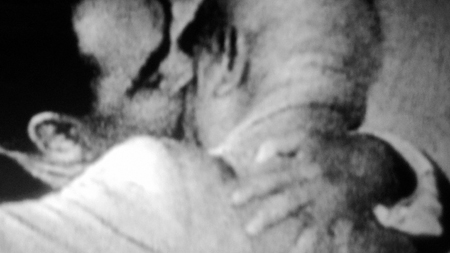
Leonid Brezhnev and Nikita Khrushchev, Moscow, April 1964 (Double Take, 2009)
The Real Double |
I.
If you meet your double, you should kill him.
But who is your double and how do you know?
If the double is connected with death, indeed, with murder (or is it self-defence?) then identifying one's double is no trivial task. It's a pressing one, particularly if one's double has received the same advice. It's a matter of life and death, of kill or be killed. It could even be a matter of preparation, defence, reaction time. A few minutes could be decisive.
Who, then, is my double and how do I know?
There are numerous options, too many, really. Here are some:
1. The double is a copy of me; my clone. As anxious B movies and thrillers attest; we are suspicious of clones, replicants. We suspect that duplication is necessarily duplicity. One is natural. Two are monstrous, a horror the clone's ontological uncertainty compounds: if clones don't know they are clones, if they think they are real, my confidence in my own reality doesn't count for much.
2. The double is not quite an identical copy, but too close for comfort, nevertheless. This double is my twin, one who accompanied me in utero, who was with me before I was born. If my twin dies at birth, I am shadowed, haunted: why not me? What would she have been like? If my twin is born and lives, the two of us are perpetually linked together, sharing birthdays, subjected to twin studies, reminded of the uncanny ways we will inevitably do the same things, at the same times, somehow destined never to be our own person but always another's person as well. We will be urged to live separate lives, to develop individual identities of our own, condemned to monstrosity if we remain too close, too together.
Those of us who are not twins often see twins as uncanny, awry—one with two faces, a two-faced person we can't quite trust. How do we know which one is which when they are two? How can we avoid being tricked, fooled, duped? Doesn't their doubleness make them complete, a couple, a unity into which the rest of us can only intrude?
In David Cronenberg's 1988 film, Dead Ringers, Jeremy Irons plays identical twin gynecologists, Beverly and Elliot Mantle. The movie is based on the novel Twins by Bari Wood, which is itself based on the true story of New York twin gynaecologists, Stewart and Cyril Marcus, who died in the summer of 1975, presumably of causes related to drug addiction and withdrawal. In each version of events, the brothers go to the same high school, college and medical school, ultimately sharing a medical practice focused on fertility. In the novel, the brothers become lovers, increasingly isolated in their mutual absorption as they sink into drug addiction and death. The novel opens with the twins as young boys in front of their old Yiddish grandfather: "In the old country, they say that twins are cursed... not one person, yet less than two." From the speculation in the New York press following the doctors' deaths—they were found dead in an apartment bolted from within; one was in an extreme state of decay, the other not so much; one was wearing socks, the other shorts—accounts of these twins fixate on the jouissance of their mutuality, whether it be in their drug use, medical practice, or immersion
in narcissistic sexual enjoyment. A contemporary, rather less disturbing instance of the imaginary enjoyment of twins is in the US reality television show, The Girls Next Door. The show focuses on life at the Playboy mansion, where Hugh Hefner, founder of the Playboy empire, lives with three blonde girlfriends, two of whom are identical twins.
3. Perhaps the double is, as the tabloid magazines would have it, my mini-me, my child. Capturing images of celebrity children, the tabloids render them not simply as fashion accessories but as something slightly more unnerving, replications of their famous parents. As if they were installing or bowing before a hereditary aristocracy, the photographs elide star and child, actor and progeny, amplifying the reversal from active to passive. To be a celebrity is to be known for being known, a circuit that, set in motion, can continue and branch and spread from object to object, in a kind of extra twist of reflexivity: celebrities are those who are known for being known by celebrities.
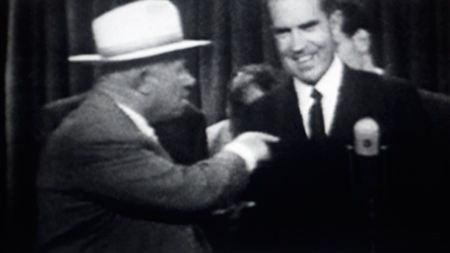
Soviet General Secretary Nikita Khrushchev and US Vice-President Richard Nixon. The Kitchen Debate: First televised Summit, Moscow, July 1959 (Double Take, 2009)
4. Then again, the double could be a kind of fake, a forger, mime, or impressionist. Imitation is supposed to be a kind of compliment, the highest form of flattery. Why, then, do the greatest mimics and impressionists cause a bit of pain, inflict a bit of a wound? They take a seemingly inconsequential tic or weakness, a little nugget that is barely anything yet still somehow constitutive of who we are, and display it for all to see; they expose us. The mime makes my gesture his. We don't both get to keep it. After it is foreign to me, alienated from me, it can't be mine the way it was, even though I may not be able to shake or avoid it.
5. The double could be my stand-in—a body double or stunt double or vocal double, one occupying my place because I can't quite be bothered or until I am ready to occupy it myself. Poor double—why didn't they make their own life? Why did they need mine? What are they lacking, these doubles? They lack singularity, uniqueness, but what else? What really makes them incomplete, unreal? What is their lack and what if it overlaps with mine?
Still, the stand-in can be a big boost to my ego. It's flattering that I'm so much, so needed and important, so valuable, that I have to occupy more than one body—maybe this suggests the appeal of the double in politics (or, more specifically, to Third World dictators): I have to be in more than one place, I cannot be replaced, and they, my enemies, should never be able to place me. We might observe here that it's no surprise that Alfred Hitchcock lost an Alfred Hitchcock lookalike contest—of course he doesn't look like Hitchcock; he is Hitchcock. But if he doesn't look like Hitchcock, what does that mean for his stand-ins? Are they more Hitchcock the less like him they look?
6. The stand-in suggests yet another version of the double, the double as usurper, the one who can and will take my place, the double as my replacement or substitute. If I think of myself as singular, as irreplaceable, this double will be particularly threatening. He destroys what it is that makes me "me", my status as a unique person.
In his 1997 film, dial H-I-S-T-O-R-Y, Johan Grimonprez positions the terrorist as such a double of the novelist. Remixing Don DeLillo's White Noise (1984) and Mao II (1991), he inhabits the usurpation, the displacement of art by violence as a force capable of altering the inner life of the culture. "Now bomb-makers and gunmen have taken that territory. They make raids on human consciousness."1 Grimonprez reflects, redoubles, these raids, highlighting the explosive power of the media that drive them, television and, later, video-recording. Novelists, DeLillo and Grimonprez observe, sold or lost out as terrorists emerged as vectors of meaning, as forces of discipline and conviction capable of being noticed. But television, the circulation of everintensifying images, our circulating through the dial in search of something else, usurped the terrorist. "So we turn to the news, which provides an unremitting mode of catastrophe. This is where we find emotional experience not available elsewhere. We don't need the novel... We don't even need catastrophes, necessarily. We only need the reports and predictions and warnings."2 Hijackers depended on media to broadcast their messages. The same broadcasts, though, necessarily hijacked the terrorist content, repackaging it in the tasty bits suited to the consumer event. The image is the double as usurper.
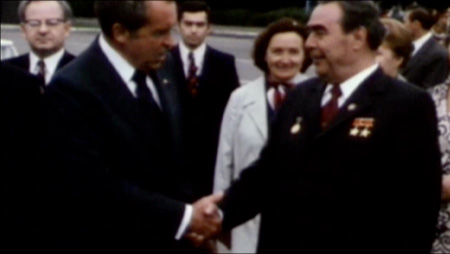
Richard Nixon versus Leonid Brezhnev.
7. My double might be my shadow, the dark outline I cast and cannot avoid.
8. My double is my reflection, me, inverted, in a looking-glass world I see only partially and never enter. How much of me does this double invert? Is he the saint for my sinner or my obscene underbelly? Which of us is Doctor Jekyll and which is Mr Hyde? If we are two sides of the same coin, who is on which side? What is our currency? Fear? Enjoyment? Diversion?
9. And, maybe, my double is me, in another time, my future me looking back, finding himself in a double take. One of us confronts the other: with regrets? With recrimination—how could you, how could I? With curiosity—what happens? Does it work out? Tell me what to do! Can I meet this double with any hope or must I squirm under the burden of knowing that he knows the mistakes I will have already made?
Joan Copjec writes, "It is our own jouissance which cannot be escaped, got rid of, even though we never manage to claim it as our own. It is jouissance that not only singularizes us, but also doubles and suffocates us... Jouissance makes me me, while preventing me from knowing who I am."3 My double knows things a stranger couldn't know. I suspect that she knows the secret of my enjoyment, but perhaps not. After all, I don't know it. I can't know it. If my double is me, then what is unknown to me is unknown to her as well.
If you meet your double you should kill him. I've mentioned nine possible doubles. This is starting to look like a bloodbath, or to suggest how it is that a concern with doubles and doubling could end up featuring beautiful images of nuclear blasts, atomic explosions, hydrogen bombs, the ultimate destruction of the world haunting the Cold War. My doubles redouble, exponentially, in an excessive, violent, chain reaction. I can't kill them fast enough.
Perhaps a different approach will save some lives. Either/or can be doubled by both/and, a doubling that necessarily leads to three options. Jacques Lacan famously distinguished between the three registers of the imaginary, the symbolic, and the Real. Slavoj Žižek argues that each of the three registers itself appears in three registers, such that we have something like the imaginary imaginary, the imaginary symbolic, the imaginary Real and so on. Although this complication may seem to reinforce the likelihood of having to kill at least nine doubles, it's clearly overkill: not every double is the Real double. So, which one is? And how do we know?
An initial reading of Double Take suggests that the "me" of the time warp, of the twist in time that enables me to encounter myself, is the Real double. Not only does Hitchcock meet himself but he dies in the end. This answer to the question of the Real double, however, could be hasty, as if one is trying to avoid confronting the way that the uncanny, and often very funny, effect of Double Take is closer to that of the missed encounter. Double Take confronts us with anxiety, with the sense of "being doubled by an inhuman, impersonal partner, who is at the same time me and disquietingly alien".4 This anxiety is the experience of our necessary failure ever to encounter our Real double, even as we can never fail to avoid him—or her. It is also the anxiety pervading, indeed, constitutive of, the Cold War and confronting us when we look back at it, when we see it as one of the sources of what we have become. After all, things could have been otherwise—clearly worse, the mushroom cloud, but maybe better. We'll never know.
If you meet your double, kill him. But maybe the Real double is precisely the one we cannot meet but cannot avoid. The Real double, the one who accompanies us, shadows us, taunts us, the one who causes us most anxiety, occupies this impossible, alien, position. Its place is a gap, in Žižek's terms a parallax gap, marked by a shift from "cannot avoid" to "cannot encounter" without ever occupying the position of encounter between them. Copjec writes, "But instead of breathing freely, we begin to asphyxiate in the air of an overly proximate otherness. This sense of being overburdened and doubled by jouissance, of an embarrassed enchainment to an excessive body" is the anxiety of encountering the jouissance of our own being.5 The Real double is already in us, part of us, a disturbing object or excess that may impress itself on us like a voice or a gaze. We cannot meet the Real double, so we don't need to be enjoined to kill him if we do. Killing the double is thus the fantasy that holds the place of this impossible meeting, a masochistic fantasy of self-annihilation. (Žižek views this enjoyment in provoking one's own ruin as the part of the ambiguous charm of the Hitchcockian villain; that the villain experiences his guilt gives his subjective position an ethical dimension.6)

Jimmy Carter versus Leonid Brezhnev.
II.
A remarkable achievement of Double Take is the way that the double is not simply one side of a static binary opposition but rather an active, seemingly limitless, doubling or redoubling. In an interview with Chris Darke in 2007, Grimonprez mentions this redoubling in connection with the relentless documentation part of the Looking for Alfred (2005) project: "Not only were we looking for a Hitchcock double, but the idea of having the project itself double—and then doubling and doubling further—was there from the very beginning."7 Two, four, eight, sixteen, thirty-two, sixty-four, one hundred and twenty-eight; the very process of doubling takes us further from a double, our double, as if it were or could be one, as if the Real double were one we could encounter rather than a gap or rupture. Repetition, in this view, is less the trap of the same than a network of unfolding possibilities. To be sure, these possibilities are not detached from anxiety. Rather, insofar as each doubling takes us further away from the very beginning, whatever that might be, it brings us closer to "the risk of annihilation, of being devoured by the very insubstantiality of the unrealized".8
These days, many of us experience this insubstantiality online: there is always another link, another video, another blog, another comment, another game. One minute turns to two, to four, to eight, to sixteen. Our own searching, linking and archiving is redoubled as traces that can themselves be searched, linked, archived. An archive of searches makes incompleteness an unavoidable feature of what must now necessarily remain fragmented and partial.
The persistent looking back at the early days of colour television, live global satellite feeds and video recording characteristic of Grimonprez's film-essays suggests that our experiences of online insubstantiality emerge out of a change "in the way we plugged into reality". dial H-I-S-T-O-R-Y recovers the carnivalesque dimension of hijacking. Grimonprez's footage of sexy, mod flight attendants and a press interview with a cheerful boy who had a good time—the hijackers were "real nice"—shortcircuits the now dominant image of the evil, criminal, terrorist. Even the violent sequences of exploding planes appear differently: on the one hand, tactics of oppressed people engaged in serious political struggle; on the other, the screen face of upbeat seventies disco music. To dial history isn't to call up or access a singular truth of hijacking or terrorism. It's to find in the switches of the dial the multiple unrealized turns that were present but unrealized. What if hijacking had inspired masses of oppressed and exploited people into overthrowing repressive regimes? What if hijackers had been able to retain control over their message, their image? What if the apparent antagonists of the Cold War, the US and the USSR, had not agreed to condemn hijacking? What if it all hadn't become so terribly bloody and violent?
In the interview with Darke, Grimonprez associates the change in how we plug into reality with "the way we relate to the world through its double, through its representation".9 Given the excess of doubling Grimonprez deploys, the doubling he performs and the redoubling that renders the doubles uncountable—in fact, that makes counting them itself yet another exercise in doubling—the term "representation" is misleading. The immediacy of feeds and screens and the awareness that those of us raised on television have of the way that things appear, the way that things, events, persons are made to appear, and the way that this very being made to appear incites a reflexive circuit as it doubles in on itself, is not representation at all but rather the splitting in and of appearance into doubled and redoubled paths, tributaries, and networks. At stake isn't "what's going on in the real world" but how the Real necessarily exceeds and ruptures attempts to capture it in a world.
Consider Double Take's images of Richard Nixon. In the first third of the film, Nixon seems to be encountering his double, Nikita Khrushchev, in the Kitchen Debates in Moscow in 1959. Yet even as each man might be figured as defending a side in the Cold War, and television newsman Walter Cronkite certainly represents the exchange this way, Nixon isn't Khrushchev's equivalent—Nixon is the Vice President, not the President. He and Khrushchev don't occupy the same symbolic position. And there is another twist as well, a twist that involves the very terms of Cold War, the measures of the race, the technologies through which their competition is carried out: while Nixon acknowledges Soviet superiority in rocketry, he asserts US superiority in television (and Grimonprez reminds us later in yet another twist that the very term "television" was coined by a Russian).
This technological doubling at work in the Kitchen Debates is more than just a doubling: it is the site for staging the opposition between television and rocketry. Television is more than rocketry's other; it's where the competition between television and rocketry appears as a competition. Television is redoubled as itself and one of its contents. Nixon attempts to make Khrushchev aware that their conversation can be transmitted immediately far beyond its setting: that is, to alert the Soviet leader to the fact that their conversation is appearing to a larger audience. And even as Khrushchev continues, seemingly unaffected, we feel Nixon's sense of being seen. It's as if Nixon is troubled, even rendered rather passive, by being the object of the very technology he has invoked as a signifier of US achievement.
In the second third of the film, Nixon appears with another potential double, a competitor for the seat of symbolic authority, John F. Kennedy. Yet while each may seem to occupy an equivalent position, the two alternatives in a binary choice, we already know that they are not symbolically equal. In retrospect, it's clear that they were never really symbolic doubles. Nixon resigned in disgrace; Kennedy's assassination made him the bearer of the lost hopes of a generation, his death an erasure not simply of lost potential but of the myriad moves and choices amplifying Cold War anxieties and US militarism.
In the clips from the televised debate between the two candidates for the US presidency in 1960, Grimonprez provides some tight close-ups of Nixon, accentuating Nixon's anxiety. These images highlight a paradox: Kennedy is denying the importance of television even as television is ensuring his victory. He is denying the very means of his own triumph over Nixon, in a way echoing Khrushchev's own preoccupation with rockets. Nixon, ever anxious about how he appears, is again rendered passive. His awareness of the gaze doesn't enable him to change or alter his appearance but entraps him in the sense of being made to appear, made to appear in a way he doesn't want to, made to appear less desirable, less appealing, than Kennedy. The split, then, is not between appearance and representation but a split within appearance. Kennedy's representation of television (as not a significant element in the Cold War) is displaced by the appearance of Nixon's appearing.
The third version features the remaining alternative: Kennedy and Khrushchev. Tensions are high; television, newspaper and radio echo and intensify the stakes, the risks, the edge of global annihilation. Yet in this third encounter, the doubles don't meet, not face to face, not ship to ship or missile to missile. Well, they do, briefly, for a bit, in Vienna, but the moment passes, uninvested, barely televised, hardly a key moment of Cold War accelerated anxiety. It's almost as if this were a chance encounter or even rehearsal for the bigger encounter, like a run though before the Real thing. The Vienna meeting, then, doesn't really count. The significant encounter is the one that doesn't take place. The Cuban Missile Crisis is the ultimate failed encounter, one that we repeat and revisit in the trauma of proximity to annihilation.
The doubles don't meet, crisis is averted.
Or is it? In the version of the Cuban Missile Crisis that Grimonprez presents, there are still losers. Someone has to die. Khrushchev is ousted and Kennedy is assassinated. So was there in this missed encounter a meeting with the Real other?
The Cuban Missile Crisis is an odd sort of event, one comprised primarily of an absence, of what did not happen, but could have happened. So there was intense anticipation and anxiety, the possibility of nuclear war, of the end, but, in the end, there was no nuclear disaster. We recollect, then, our fear, our anticipation, our anxiety, reliving the tension—something horrible could have happened. And indeed the anxiety and anticipation is the best part of the story. The outcome, the compromise involving missiles in Turkey and the like (a compromise historians tell us was really just for show) is barely remembered, a minor diplomatic settlement, not like giving up Poland. Joan Copjec observes that the edge that anxiety touches is the "unrealized, the 'thrust-aside' powers of the past that might have caused my personal history or history tout court... to be otherwise". Our anxiety, she tells us, is born out of our encounter with the "risk of annihilation, of being devoured by the very insubstantiality of the unrealized."10
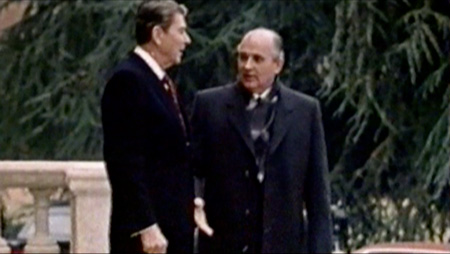
Ronal Reagan versus Mikhail Gorbachev.
Copjec is surely right about anxiety and insofar as the Cuban Missile Crisis is one of the Cold War's, indeed the twentieth century's, defining events it makes sense to understand the anxiety it incites in terms of this risk of annihilation. But why do we return to it? Why do we repeat the anxiety? Why do we participate in repetitive practices through which we experience, again and again, this brush with annihilation, with being devoured?
Easy answers moralize the event, instructing us to learn from the past, to appreciate that the worst could happen. They enjoin us to disarm, to seek peace, to appreciate how close we came to oblivion and to work to make sure that we never get to this point again. These sorts of answers might figure in Kennedy nostalgia or even in nostalgia for something like a simpler world, one with clear rights and wrongs, erasing as they do the reality of Cuba as a country with its own revolution and politics not to mention the fact that there has been, if not nuclear war, then the use of nuclear weapons in war, against the civilian populations of Hiroshima and Nagasaki.
Grimonprez's Cuban Missile Crisis avoids this nostalgia and moralizing even as it accentuates anxiety, revels in anxiety, plays anxiety like a canon or collage, like a montage or mash-up. It makes me think of Lacan: we repeat because we enjoy. The beautiful, shocking, impossible mushroom clouds, luminously expanding to occupy the entire field of vision—Grimonprez enjoys explosions, from the cockpit engulfed in flames in dial H-I-S-T-O-R-Y to the nuclear tests of Double Take; each blast mesmerizes as it disrupts the normal order of matter and energy. And these aren't special effects. We know that. We've seen the footage before and we know that the explosions are Real, even if we don't know why. We witness their power, their destruction, and in witnessing experience ourselves as beyond or outside their violence. Witnessing, we survive the crash, the bomb in the cargo hold. Present at the end of the world, we can continue to inhabit our fantasies of immortality: we imagine the annihilation of everything, except ourselves, the ones who are seeing, witnessing. We can withstand the sublime power of the nuclear explosion, as if our power were more, were excessive, were without limit or boundary. We witness and enjoy an infantile fantasy of omnipotence for which we need not take responsibility: the Cuban Missile Crisis is a story of a failed encounter; nothing exploded; so we can sit back and enjoy power in its sublime excess.
Might it not be the case then that we enjoy a fantasy of omnipotence, that in the midst of the failures of the present, the present's overwhelming sense of failure on all sides (the crisis of neoliberalism is also a crisis for neoliberalism) we return to and enjoy fantasizing our ability to destroy the world? Or, is this move too quick as well, occluding what we might call the gaze of the Cold War? Žižek observes that part of the power of film noir is our fascination with the gaze of the naive spectator, the one who takes it seriously or who "believes in it for us, in place of us".11
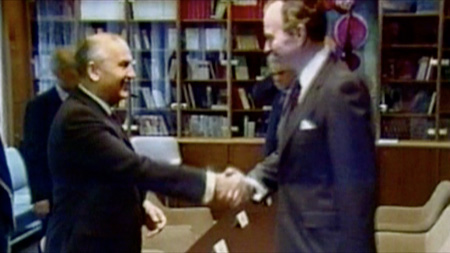
Mikhail Gorbachev versus George Bush Sr.
The appeal of the Cold War footage Grimonprez uses so well in his films stems at least in part from the way it enables us to posit people who really believed in communism, in capitalism, who believed in a global fight, and whose belief gave them not only something worth dying for but something worth the destruction of the world. In dial H-I-S-T-O-R-Y we see Soviet citizens mourning their fallen leaders, weeping for Lenin, weeping for Stalin. We see Chinese communists attempting what now seems impossible—a total cultural revolution. We see hijackers who know what they want and why. In DeLillo's words, "In societies reduced to blur and glut, terror is the only meaningful act... Who do we take seriously? Only the lethal believer, the person who kills and dies for his faith."12 Even on the capitalist side, what seems to be a pointless waste of money—stockpiling weapons—a senseless venture to the edge of oblivion— risking nuclear war, becomes, from the perspective of the Cold War gaze, a matter of the beliefs that matter, the beliefs that cut through daily preoccupations with provisioning to occupy the very ground and purpose of human existence.
What fascinates us in the Cold War encounters in dial H-I-S-T-O-R-Y and Double Take, and which appears so vibrantly in the missed encounter of the Cuban Missile Crisis, is the gaze of those who believed. We fantasize their belief, trying to occupy their position, to look on the Cold War as something that could have mattered. The films insert us in moments we imagine as full of alternatives, as forks, as if capitalism were not inevitable, as if collective aspirations and projects could change the world. Fantasizing this younger, earlier gaze of the Cold War, we are the older, decrepit, undead other, circulating round and round in the loss of our ability to produce, to direct, our own world. No wonder our younger self has to kill us. That fantasy that he can is our way out.
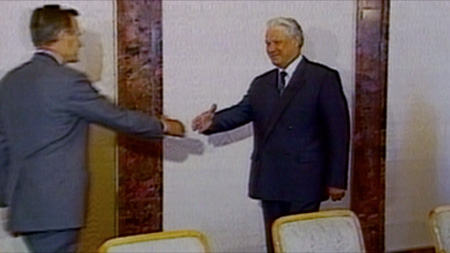
George Bush Sr. versus Boris Yeltsin.
III.
Grimonprez uses the missed encounter as an opportunity to make an encounter with the Real other appear. Such an encounter is impossible directly, only possible accidentally or anamorphically. I've considered it in terms of absence, fantasy and gaze, each oblique approach twisting and splintering into the others. And I've argued that Grimonprez's presentation of the Cuban Missile Crisis as a missed encounter confronts us with the particular anxiety of our enjoyment, whether of power, opportunity, or even failure. We meet our double and he kills us. Fascinated by the gaze of our prior Cold War selves, we imagine that other futures had been possible, futures of terrible nuclear annihilation, but also, perhaps, of forms of collective enterprise and aspiration not already absorbed by the circulation of commodities and the drive for profit.
Which leads to the commercials. Commercials figure differently in dial H-I-S-T-O-R-Y and Double Take. In the former, they mark narrative gaps. Such gaps indicate the capture of hijacking in the televisual image, in television as medium for delivering consumers to advertisers, and in viewers' capacities to avoid commercials (whether by walking out of the room, changing the channel or, after the introduction of the VCR, forwarding past them). How seriously can we take the murder of a pilot and the unceremonious tossing of his body through the cockpit window when it's followed by a commercial? How much of an event do we encounter when all we have to do is turn the channel to avoid it, to find something more pleasant, funnier or even more shocking? As Grimonprez notes in an interview that appeared soon after the release of dial H-I-S-T-O-R-Y, "on TV, imagery becomes more and more extreme and the accumulation of images more rapid: the TV set has swallowed the world. Reality has lost credibility. Even when confronted with real death one feels detached, as if the violin strings are missing in the crucial scene."13 The very gaps breaking up official presentations of news and events, the gaps that open up possibilities of escape, are at the same time gaps derealizing the world as they increase its insubstantiality.
Double Take, in contrast, is punctuated by Folgers commercials that we look back at in near wonder—when were we, when was television, ever so young, so naive? Even more than the news footage, the commercials take us back to the beginning of the sixties as a time of opportunity and aspiration. With them we return to the space of domestic fantasy that early television staged so well. The straight young couples, dressed up for dinner (they won't start swinging, swapping keys and wearing jeans for at least five more years). We grin, with just a bit of superiority: women aren't confined to looking for the best coffee anymore (now we can all look for good coffee, and pay four euros a cup for it at Starbucks).
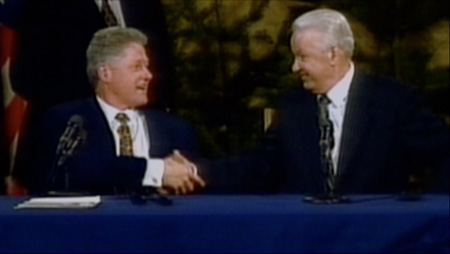
Bill Clinton versus Boris Yeltsin.
Yet the commercials Grimonprez mixes in, humorously, delightfully, breaking—and helping build—the tension of political and Hitchcockian events, bringing with them the Cold War gaze, these very commercials double the anxiety Double Take incites. They remind us that rather than actually a time of opportunity, rather than really a fork, the years of Khrushchev and Kennedy were already determined. As they constitute the space of appearance, the television commercials make clear that the deal was done, the gig was up. Hitchcock asks Hitchcock who won the Cold War—but Hitchcock dismisses the question as trivial. The commercials advertise products and incite insecurity (but less about nuclear war than about bad coffee and worse marriages). The Cuban Missile Crisis appears like a fork, but the space in which it appears—marked in the film by television—makes clear that there wasn't a fork at all, the road was already built in one direction, that of capitalism. The moment of choice, of encounter between communism and capitalism, was already behind us, having never appeared at all. The commercials, in other words, suggest less the space of a struggle between consumers armed with remotes as advertisers fire at them fantastic images designed to incite their desires than capitalism's triumph that is, the inevitable acquiescence to capitalism, and not just capitalism as in markets unleashed to the brutal pursuit of monopoly and profit but a fantasy of capitalism as a haven of privacy, domesticity, and the individualized pursuit of happiness. Derealization is a specific effect media produced in and as the Real of capitalism.
Since at least Guy Debord's work on the society of the spectacle the idea that television is a medium for transmitting fear has often been repeated. It has likewise been common to note that television, particularly in the United States which is dominated by commercial television, is primarily a delivery system for advertisers, a way to give them access to consumers; in fact, to turn rather amorphous, undetermined beings into lacking beings that nonetheless enjoy, even if that enjoyment is little else than a cup of coffee, satisfaction over making it, or the little charge of amusement at commercials in their/our idiocy. Yet it has less often been noted that television's transmission of fear is its transmission of capitalism and this not because of its content but because of its form, its emergence as the space within which anything that opposes it has to appear. The remarkable achievement of Double Take is this coupling, this doubling of the Cold War and its television setting that makes the conflict end with its televisual appearing and still be an occasion for anxiety. It's important to note, moreover, that mobile personal media extend and deepen this phenomenon rather than challenge it, a point to which Grimonprez alludes at the end of dial H-I-S-T-O-R-Y with video-cam footage of the crash of a hijacked plane taken by a honeymooning couple.
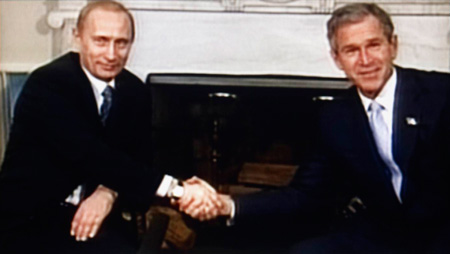
Vladmir Poetin versus George Bush Jr.
IV.
When we say that someone did a double take, we are saying that they looked again, looked back. They saw something and rather than assimilating what they saw into the manifold of impressions, they were pushed, impelled, to look at it again. With a double take, it's not that the person chooses or decides to look again, to look back; rather, they find themselves already looking back.
What makes one look again?
A rupture or a glitch, a disconnection or seam, a fault line in the manifold of impressions that, somehow, is more than that manifold. The plenitude of sensory impressions, the multiplicity in which one persists, at that moment exceeds itself. Some kind of excess in the field calls attention to the field. The Lacanian term for that excess rupturing the field is "the gaze". The gaze, then, isn't what the viewer sees. It's what makes her look and become aware that she is looking. The gaze confronts the viewer in her viewing, disturbing it, denaturalizing it, making what was formerly seamless appear with seams, with cuts, with splices.
Set in a media habitat filled with interruptions, with cuts and splices, segments and segues, the gaze, rather than becoming more apparent, retreats. The field itself seems comprised of bits of footage, multiple layers of impressions impressing themselves into layers. Interrupting this field of interruptions thus becomes a challenge: what makes one interruption different from another, what lets it effect a rupture and become an opportunity for an encounter with the Real of the gaze rather than simply another moment in the imaginary? In a field of interruptions the gaze manifests itself as an interruption of the interruptions, a bracketing that makes us say, "But wait! there's more", and that in so doing calls us to look back on our looking. We find ourselves already lost in it, already having turned.
Paper presented at the symposium "Shot by Both Sides! Double Take", Arts Centre Vooruit, Ghent, Belgium, 15 October 2009.